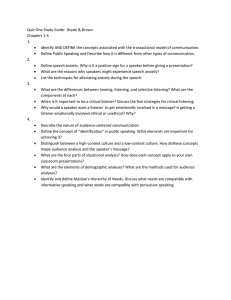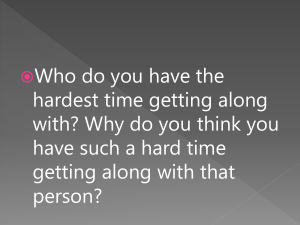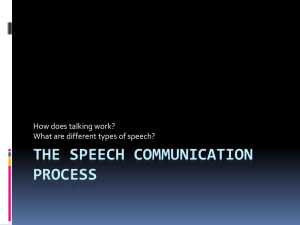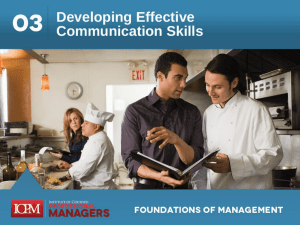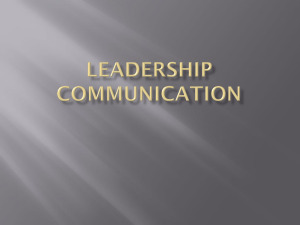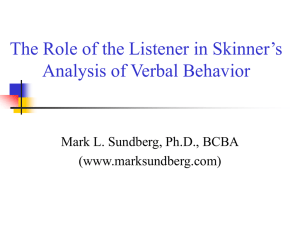File - Springville High School Business & Computers
advertisement
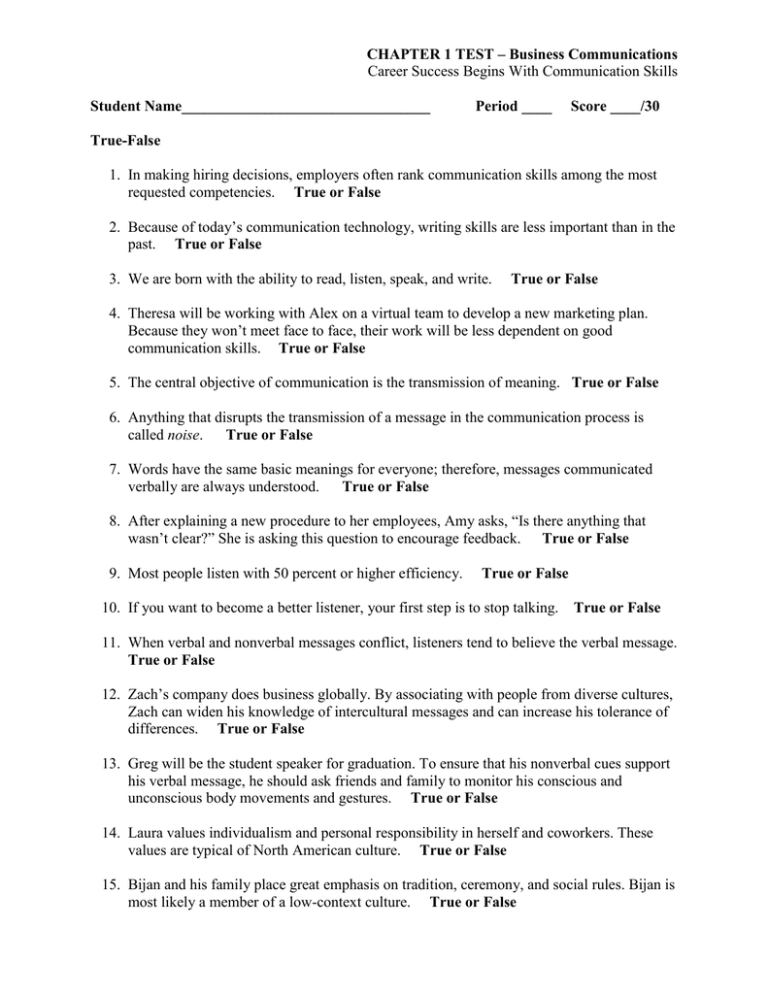
CHAPTER 1 TEST – Business Communications Career Success Begins With Communication Skills Student Name_________________________________ Period ____ Score ____/30 True-False 1. In making hiring decisions, employers often rank communication skills among the most requested competencies. True or False 2. Because of today’s communication technology, writing skills are less important than in the past. True or False 3. We are born with the ability to read, listen, speak, and write. True or False 4. Theresa will be working with Alex on a virtual team to develop a new marketing plan. Because they won’t meet face to face, their work will be less dependent on good communication skills. True or False 5. The central objective of communication is the transmission of meaning. True or False 6. Anything that disrupts the transmission of a message in the communication process is called noise. True or False 7. Words have the same basic meanings for everyone; therefore, messages communicated verbally are always understood. True or False 8. After explaining a new procedure to her employees, Amy asks, “Is there anything that wasn’t clear?” She is asking this question to encourage feedback. True or False 9. Most people listen with 50 percent or higher efficiency. True or False 10. If you want to become a better listener, your first step is to stop talking. True or False 11. When verbal and nonverbal messages conflict, listeners tend to believe the verbal message. True or False 12. Zach’s company does business globally. By associating with people from diverse cultures, Zach can widen his knowledge of intercultural messages and can increase his tolerance of differences. True or False 13. Greg will be the student speaker for graduation. To ensure that his nonverbal cues support his verbal message, he should ask friends and family to monitor his conscious and unconscious body movements and gestures. True or False 14. Laura values individualism and personal responsibility in herself and coworkers. These values are typical of North American culture. True or False 15. Bijan and his family place great emphasis on tradition, ceremony, and social rules. Bijan is most likely a member of a low-context culture. True or False CHAPTER 1 TEST -- Business Communications Multiple Choice 16. One of the fastest ways to ensure your career success is to a. learn how to design Web pages. b. post a persuasive résumé online. c. develop excellent communication skills. d. invite your boss out to lunch periodically. 17. On the job you are more likely to be taken seriously and promoted if you a. look and sound professional. b. frame your degree or certificate and hang it on your office or cubicle wall. c. appear to be busy even when you’re not really doing anything. d. do all of the above. 18. Communication is defined as “the transmission of information and meaning from one individual or group to another.” The crucial element of this definition is _______________. a. transmission. b. information. c. meaning. d. all of the above are equally important. 19. The communication process begins when the sender a. determines the appropriate communication channel. b. has an idea. c. encodes an idea into a message. d. plans for feedback. 20. Many of us are poor listeners because a. the brain can process information at least three times as fast as people talk. b. we tend to “tune out” speakers whose ideas run counter to our own. c. we would rather talk than listen. d. All answer choices are correct. 21. You can improve your listening skills if you follow tips for active listening, including a. keeping an open mind, establishing a receptive mind-set, and listening between the lines. b. establishing a receptive mind-set, concentrating on appearance and delivery, and sifting information through biases. c. capitalizing on lag time, concentrating on your next comment, and taking as many notes as possible. d. All answer choices are correct. 22. A listener who nods her head and maintains eye contact with a speaker is probably a. listening actively to what the speaker is saying. b. not understanding what the speaker is saying. c. faking attention while she listens to music on her MP3 player. d. formulating her response to a point with which she disagrees. CHAPTER 1 TEST -- Business Communications 23. Amelia has made a conscious effort to become an active listener. Therefore, she shuts down her computer, turns off her cell phone, and asks her assistant to hold all incoming calls when she conducts interviews. What technique is she using to improve listening? a. Keeping an open mind b. Establishing a receptive mind-set c. Capitalizing on lag time d. Controlling her surroundings 24. Which of the following is considered a form of nonverbal communication? a. Facial expressions, such as a frown or raising the eyebrows b. Eye contact, such as staring or avoiding looking someone in the eye c. Time, such as showing up too late or too early d. All of the above are forms of nonverbal communication 25. Nonverbal communication includes a. all unwritten and unspoken messages, intended or not. b. only body language and gestures that accompany a spoken message. c. only eye contact and facial expressions that support the meaning of the words. d. only cues that reveal agreement with or contradiction of the verbal message. 26. Most people think that the best predictor of a speaker’s true feelings is his or her a. facial expressions. b. posture. c. gestures. d. eyes. 27. Melissa noticed that Stephen slammed his desk drawer right after he said that he was happy to work late. Melissa should a. tell Stephen that he should behave more professionally. b. respond to the verbal message only and thank him for working late. c. politely seek additional information by saying, I’m not sure that you really want to stay late. Do you have somewhere you need to be? d. fire Stephen for insubordination. 28. Communicators in _____________ cultures (such as those in North America, Scandinavia, and Germany) depend little on the context of a situation to convey their meaning. They tend to be logical, analytical, and action oriented. a. high-context b. Asian c. ancient d. low-context 29. While conducting business with a customer from Italy, Zoe was careful to speak slowly and clearly, using short sentences and short, familiar words. But she noticed that the customer had a glazed expression and did not understand her. Zoe should a. repeat what she has said in a louder voice. b. graciously accept the blame for not making her meaning clear. c. end the conversation until an interpreter can be found. d. require the Italian businessperson to restate the message in simple words. CHAPTER 1 TEST -- Business Communications 30. When speaking with someone for whom English is a second language, you should talk slowly, enunciate clearly, check frequently for comprehension, observe eye messages, listen without interrupting, and a. follow up in writing. b. avoid smiling, which might make you appear to lack seriousness. c. use vocabulary words that will impress the listener. d. assume that the listener understands if he or she nods and smiles in agreement.
